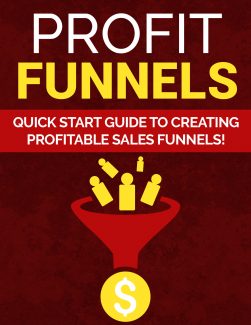 License Type: Private Label Rights
License Type: Private Label Rights  File Type: ZIP
File Type: ZIP
 SKU: 62219
SKU: 62219  Shipping: Online Download
Shipping: Online Download
Sample Content Preview
Introduction
Have you been wondering exactly how so many successful marketers are able to create incredibly profitable sales funnels that generate thousands of dollars with every launch?
The reality is, if you want to maximize your income so you can squeeze every possible dollar from your product launches, you absolutely need to master the art of creating high-converting sales funnels.
And here’s a fun fact: it’s easier than you may think.
This special report was written to provide you with a step-by-step quick start blueprint to creating outstanding sales funnels that not only maximize your profits but are aimed at keeping the money rolling in long after your initial launch phase is over.
Because a well-constructed sales funnel that’s based on proven techniques can take a simple product launch and retain the momentum weeks, even months after the launch.
Are you ready to learn the insider strategies to creating turbo-charged sales funnels that maximize your income?
If so, let’s begin!
Overview of a Successful Funnel
A sales funnel moves leads through a sales process until they make a final purchase.
It introduces people to your brand who may not already be familiar with it and puts you in a position of connecting with your target audience.
It also amplifies a typical marketing strategy so that you’re able to maximize profits and build your tribe. And it extends the life of a product launch.
The key is to create a sales funnel that makes sense to your target audience. Don’t overlook the importance of this because not every niche or industry responds the same way to a sales funnel. It’s not a one-size-fits-all approach!
To begin, you’ll want to spend some time analyzing successful sales funnel in your market. Pay close attention to the price points that you’re introduced to along the way.
What kind of upsells do they offer?
How do they move you from one offer to the next?
Take notes of everything you come across because this information will be helpful to you when you begin constructing your own funnel.
A sales funnel also helps to qualify traffic. It separates the action-takers from the tire-kickers. It works to create awareness of your brand, and to test out different price strategies to find the sweet spot.
In other words, it serves multiple purposes beyond the profitability of the offer itself.
Your sale funnel’s objective is to move traffic, and then convert that traffic along the way. You’re inviting people into your funnel in order to connect with potential customers and provide them with various options so that you’re more likely to get the sale.
Even sales funnels that feature a single front-end product are designed to showcase other backend offers throughout the process.
The one thing that many people overlook is that your funnel doesn’t have to begin with a sale. In fact, you should look at the top of your funnel as the exploratory stage, where customers are first introduced to your brand and are looking for reasons to buy from you.
This means that your funnel may not begin on a sales page at all. It could start by funneling traffic into a mailing list in order to build your subscriber base and connect with your audience.
Your funnel may start with a blog that features high-quality content and later encourages readers to become part of a Facebook group, a masterclass, a newsletter or a free course.
It doesn’t matter where or how your funnel begins. The important thing to keep in mind is that the top of your funnel has one main goal: to raise awareness of your brand and to connect with potential customers.
Your funnel’s entry point (or top of the funnel) can be created in many ways, depending on your overall objective. So, to start, think about what you hope to accomplish.
Do you want to build a mailing list of people who are interested in your niche so that you can introduce them to new offers?
Are you looking to start selling right away by creating a traditional sales funnel that begins with a low-cost front end product?
Do you want to gather important information from prospects through lead magnets, free trials, or free products before introducing them to paid offers?
Identify the main objective of the top of your sales funnel first and then build your funnel around that.
The 3 Stages of a Successful Funnel
We’ve just discussed how the top (entry) of your funnel doesn’t always have to involve selling. In fact, for many this is the last place where they’d even consider doing a hard sale.
Typically, the top of your sales funnel is the introduction phase. As I’ve previously mentioned, it’s where you allow people to get to know your brand, test the waters, and make the decision as to whether you have something valuable to offer.
Here’s how to create the top of your funnel:
Set up a lead-capture page. This can be a responsive squeeze or landing page. The focus needs to be on capturing the lead via an opt-in form that adds the subscriber to your mailing list.
You’ll want to offer something of value in exchange for their email address. Think about the different type of products featured within your funnel and offer them a condensed version of a product, or something else that is relevant to your market.
Don’t overlook the importance of a lead magnet! If you want to maximize conversion rates, you’ll want to offer them something irresistible that instantly attracts attention. A free special report, an email-based course or a series of videos are always great ideas.
If you want to save time by getting your hands on dozens of pre-made lead magnet packages that include high-quality reports, responsive squeeze pages and even autoresponder follow-ups that will help you connect with your subscribers, you’ll want to check out: https://www.swabd.com/monthly-plr-lead-magnets-package
These guys know their stuff. The lead magnet packages come fully bundled with everything you need making it drop-dead easy to get your funnel up and running in a matter of a few minutes.








